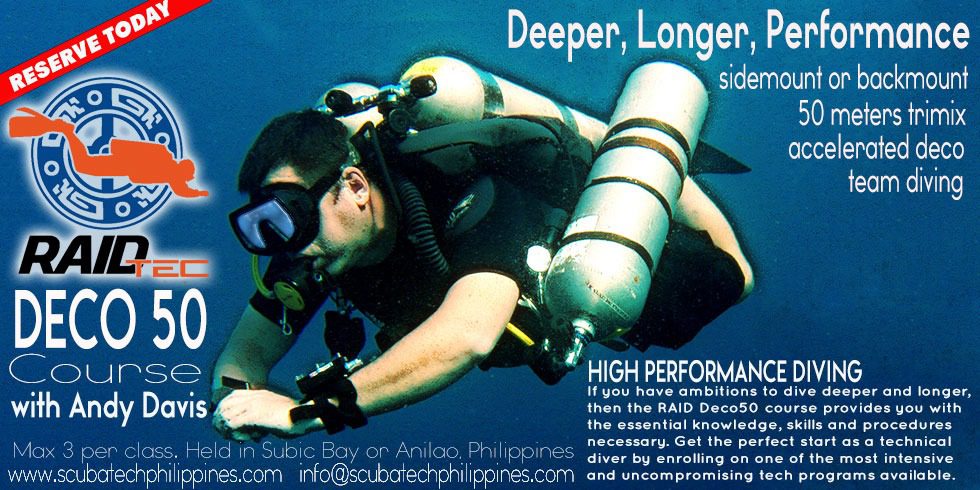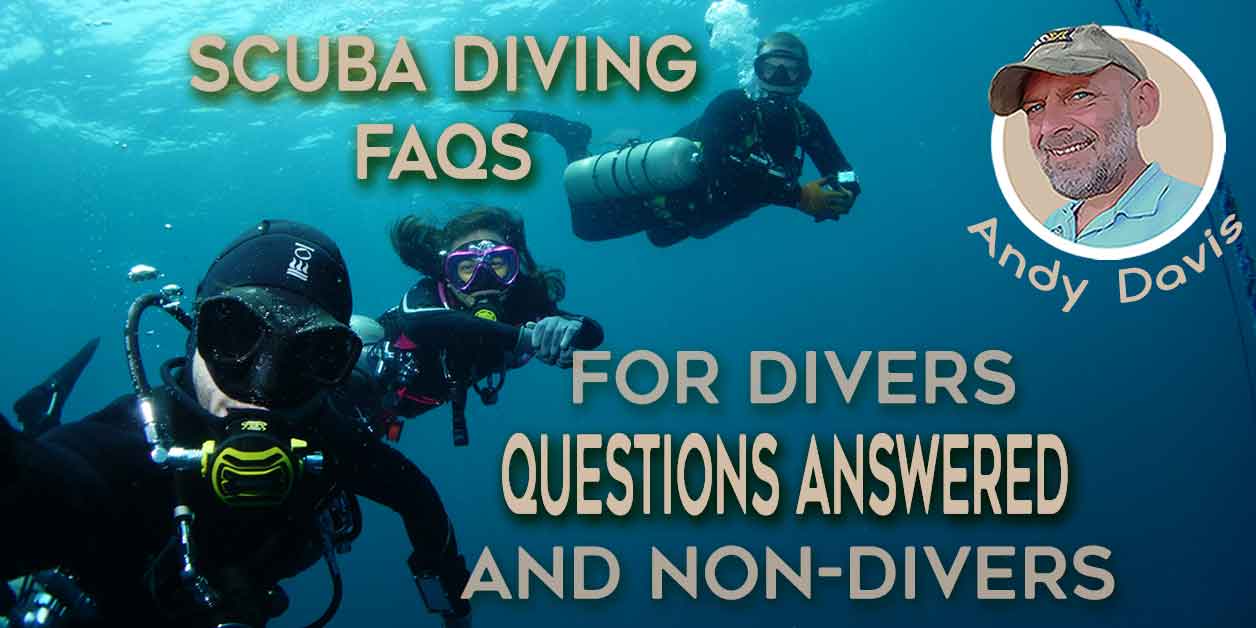Scuba Q&A
Question: I was taught that “recreational divers plan all dives to be no stop dives” and also that most agencies consider 40m /130 feet as the maximum depth for recreational deep diving. That seems inconsistent when my dive computer allows me to dive below 40m/130 feet and still stay inside no-stop limits.
Why shouldn’t I dive as deep as my computer allows me, as long as my dive is no stop? [no_toc]
 Andy’s Answer:
Andy’s Answer:
There are other criteria which contribute to most agencies setting 130ft as a maximum depth limit for recreational divers with deep diving training. Narcosis management is prime among them – and has an impact on all the other criteria.
Without technical diving training, recreational divers are not expected, by default, to possess certain key deep diving skill and knowledge competencies. Neither are they expected or required, to have a minimum level of equipment support or redundancy (beyond the existence of a buddy) to mitigate risks that increase with depth.
The criteria that need to be considered, in relation to risks when deep diving, are:
Narcosis
Nitrogen/Inert Gas Narcosis typically starts to degrade performance around 30m/100ft. The effects become much stronger for every few meters beyond that. For many divers, especially those without ingrained functional diving skills, the effects will become debilitating or at the least, significantly reduce performance, beyond 40m/130ft. Symptoms of narcosis may not be present, but a diver will still be impaired. The typical CO2 retention associated with stressful incidents (exertion and/or elevated respiration) can also cause a rapid spike in narcosis and catastrophically degrade mental performance when it is most needed to save your life.
Time to Surface
If you consider 40m/130ft in respect of ‘time-to-the-surface’ then (depending on your training agency) you have 2-4 minutes of ascent travel to reach safety should a problem arise. That is a long time to potentially have no air to breath – and beyond the capabilities of many people. In contrast, 18m/60ft (1-2 minute ascent) is easily within the capabilities of most people to achieve on a single breath/exhalation. In essence, the ‘last fail-safe’ of a Controlled Emergency Swimming Ascent can be denied to the diver.
Gas Consumption
Whilst your respiration may remain constant, there is a direct relationship between the volume of gas consumed and the ambient pressure it is breathed at. Deep diving entails highly elevated consumption of gas supplies, requiring greater situational awareness and more diligent monitoring of gauges. The duration of deep dives will be significantly limited by the gas supply available to the diver. In addition, the impact of stress on respiration rates must be acknowledged. If something goes wrong when deep diving, then your gas consumption can increase by a factor of ten and/or the diver may have to share air with their buddy.
Recreational divers rarely receive the training necessary to calculate their regular, or elevated/stressed, air consumption at a given depth and for the following ascent. Nor are they routinely educated to calculate the relationship between that air consumption and the supply of gas they will require for their planned dive or to cope with emergency scenarios, especially when sharing air with another diver.
Equipment Functionality
The effects of increased ambient pressure and workload dealing with denser gas flow cause more strain on scuba equipment. This can lead to increased risk of equipment failure. When coupled with the other factors listed, an equipment failure below 40m/130ft is significantly more serious that it would be within recreational diving depths. Whilst technical divers are trained to identify such risks and mitigate them through a calculated system of equipment/gas redundancy and refined emergency procedures, there is very little provision of these safeguards within recreational diving course syllabus.
Bottom Time
It is possible to calculate dives beyond 40m/130ft that still provide an NDL. Even the PADI RDP states a 4-minute bottom time at that maximum depth. Whether such times, especially when descent time is considered, remain worthwhile or meaningful is very questionable. At the most, the diver will be restricted to a ‘bounce dive‘ – which presents further complications and risks from a physiological/decompression perspective.
Also, as per gas consumption, the shorter duration of bottom demands a much higher degree of situational awareness and ‘gauge vigilance’ from the diver. A distraction, or any unforeseen delay, can much more easily lead to the imposition of mandatory (emergency) decompression stops, which a recreational diver is unlikely to be trained or equipped to complete with any pre-determined guarantee of effectiveness.
Decompression Sickness
Decompression software used to calculate dive times via tables or dive computers, is not an exact science. At best, it can be considered in respect of ‘statistical likelihood’. Adhering to a No-Decompression Limit does not ensure invulnerability to DCS. On a given day, a given diver will be subjected to a greater, or lesser, degree of pre-cursor factors towards DCS.
Likewise, NDLs can only be considered relative to the ascent that follows them. Failure to ascend at the correct speed, or perform precautionary ‘safety stops’ further increase risk. Divers do sometimes get bent within NDLs. Needless to say, all agencies encourage divers to plan dives conservatively; allowing a healthy buffer against their NDL. Deep diving below 40m/130ft virtually guarantees that no meaningful buffer can exist. You can get ‘unlucky’ quicker… and there is virtually zero tolerance for any mistakes.
Oxygen Toxicity
Exposure to high oxygen partial pressure (PPO2) entails the risk of oxygen toxicity (convulsions, typically leading to drowning). A healthy buffer exists between the recreational deep diving limit of 40m/130ft and the depth (~56m) where breathing air exceeds the advised maximum PPO2 of 1.4.
However, as with DCS, the risk of an incident is nothing more than statistical likelihood. You are not guaranteed immune from O2 toxicity below PPO2 1.4 – other predisposing physiological factors can have an impact on susceptibility. Few recreational divers are educated to understand those predisposing factors or calculate a prudent max PPO2 in relation to the nature of the dive they are undertaking.
Carbon Dioxide (CO2)
Carbon Dioxide plays a key role in many of the factors already listed. The retention of CO2 is a contributing factor to narcosis and oxygen toxicity risk. CO2 levels in the lungs are fundamental to respiration control – the degradation of which is a major catalyst to stress and uncontrolled panic. CO2 retention is increasingly likely as depth increases, due to the density of gas breathed and consequent workload on the lungs. This especially true when combined with exertion, narcosis symptoms, underlying stress and/or poor regulator performance. When deep diving, CO2 retention becomes a major hazard for divers.
Accumulation of Factors
In my opinion, any single one of these factors is sufficient reason to not venture below 40m/130ft, without undertaking the technical level training necessary to understand and mitigate the relevant deep diving risks factors.
Accident Chain & Risk Tolerance
When further considering the implicit relationship between many of these risk factors, it necessary to accept a high likelihood that multiple issues will manifest together, one being a result of the other. The ‘accident chain’ is stronger and more difficult to resolve when deep diving.
When the ‘tolerance’ for a single innocuous incident to devolve into serious life-threatening scenario is very small, it must be countered by a sufficiently robust system of training and equipment. Such a system does not exist within ‘recreational’ diving syllabus.
The Need for Recreational Scuba Deep Diving Limits
As you can see, there are many factors that need to be considered when deep diving. Scuba agencies set limits on recreational deep diving in recognition of those risk factors and how they relate to the training provided to divers on recreational level scuba training courses.
When a scuba diver calculates their own personal deep diving limit, in general, or for a specific dive, they should be aware of all the risk factors that apply to their safety.. and the relationship of those risks to the training and capabilities they possess as a result of previous training and experience.
Technical diving training exists to provide a safe alternative for divers who wish to venture below recreational deep diving limits. The theory, protocols and equipment approaches presented on tech courses ensure that divers can understand, and are reasonably able to mitigate, all of the risks that exist when deep diving. This approach also permits more meaningful and satisfying dives, as scuba divers are not limited to excessively brief ‘no-stop’ times, or insufficient gas supplies at deeper depths.
About the Author

Andy Davis is a RAID, PADI TecRec, ANDI, BSAC and SSI qualified independent technical diving instructor who specializes in teaching advanced sidemount, trimix and wreck exploration diving courses across South East Asia. Currently residing in ‘wreck diving heaven’ at Subic Bay, Philippines, he has amassed more than 9000 open circuit and CCR dives over 27 years of diving across the globe.
Andy has published many magazine articles on technical diving, has written course materials for dive training agency syllabus, tests and reviews diving gear for major manufacturers and consults with the Philippines Underwater Archaeology Society.
He is currently writing a series of books to be published on advanced diving topics. Prior to becoming a professional technical diving educator in 2006, Andy was a commissioned officer in the Royal Air Force and has served in Iraq, Afghanistan, Belize and Cyprus.

Originally posted 2018-03-07 23:56:52.

 Andy’s Answer:
Andy’s Answer:
